The Sony Ericsson Xperia Play: Where Do You Want To Take Your Gaming Today?
by Brian Dipert on August 8, 2011 1:26 PM EST- Posted in
- Smartphones
- Sony
- Android
- Xperia Play
- Mobile
At Brian Klug's recommendation, I ran the Xperia Play through a battery of common benchmarking tests. Below you'll find the alphabetically ordered results, in comparison to similar-featured and similar-age Android handsets from other suppliers:
Basemark (aka 3DMarkMobile) ES 2.0 V1
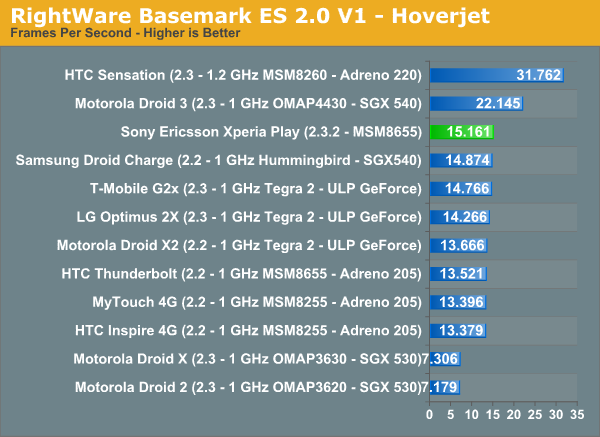
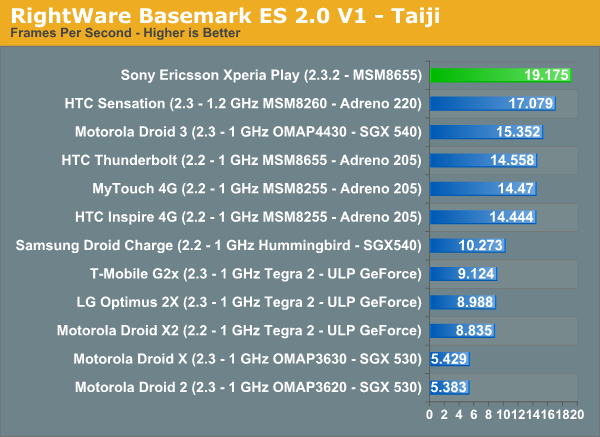
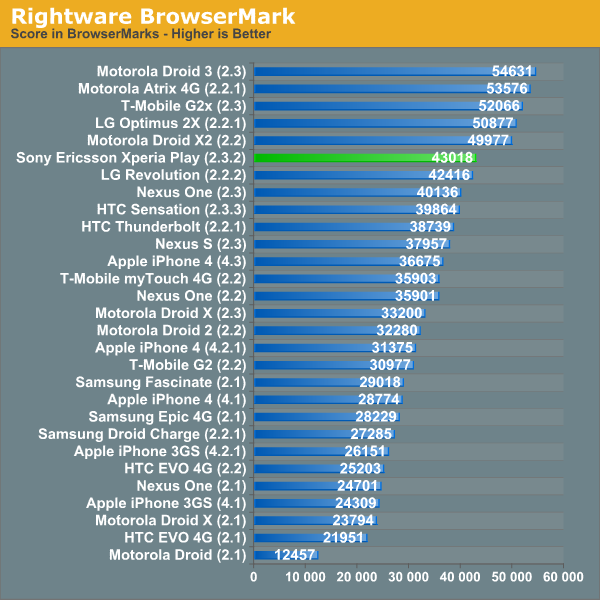
GLBenchmark 2.0 ('Standard' results in both cases)
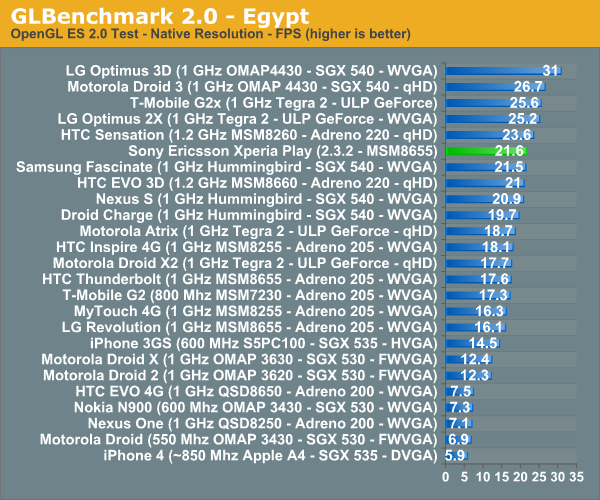
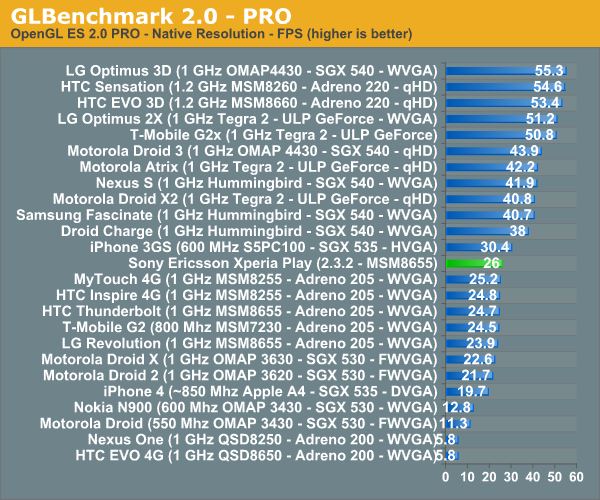
kwaak3 aka Quake 3 (note that this particular test was run with lightmaps off, per longstanding AnandTech practice)
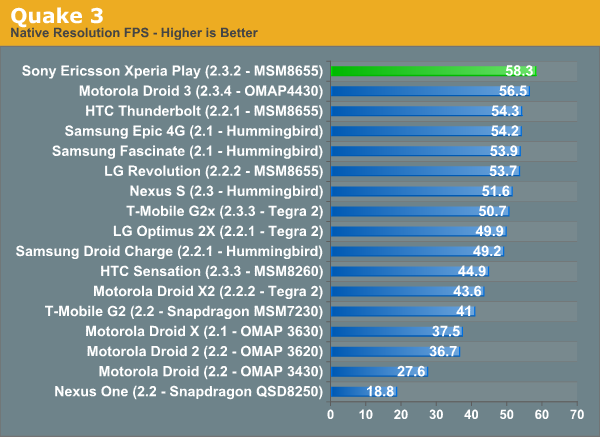
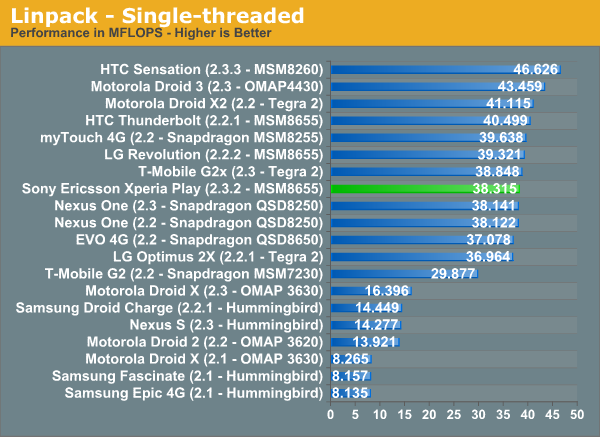

And SunSpider 0.9
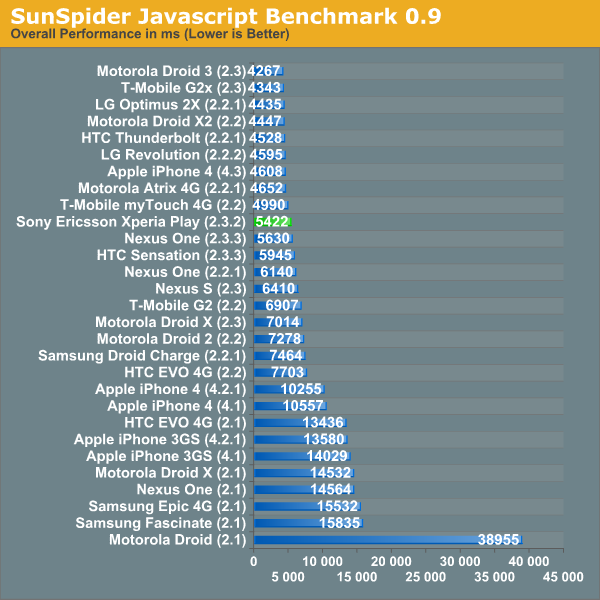
The results are largely predictable, but some encouraging surprises also emerged. Performance differences between platforms based on the first-generation 65 nm-based QSD8x50 (aka S1-class SoC) and second-generation 45 nm-based MSM8x50 SoCs predominantly derive from two factors, since the processor cores are fundamentally the same save for the process they're built on:
· Clock speed differences (800 MHz versus 1 GHz, for example), and
· Graphics core differences (Adreno 200 with the QSD8x50, Adreno 205 with the MSM8x55)
Slight variances between similarly clocked systems in CPU-centric benchmarks are likely the result of benchmark run-to-run differences, coupled with minor evolutionary Dalvik virtual machine enhancements in successive Android versions. Perhaps the most significant Dalvik improvement came with the transition to Android 2.2 'Froyo', which added a JIT (just-in-time) compiler to the mix with a resultant claimed 2x–5x performance boost with CPU-heavy code. The Xperia Play still notably outperforms its fellow MSM8x55- and Adreno 205-based peers on graphics-heavy benchmarks. This result surprised me, until Brian Klug explained that the Xperia Play represented one of the first production systems containing improved graphics drivers from Qualcomm.
Unlike with a PC, where you can regularly install updated drivers from AMD, Intel or Nvidia, with a handset you need to rely on Google and its hardware and carrier partners to bundle the updated drivers with an operating system upgrade for your hardware...or in this particular case, for an OEM like Sony Ericsson to include them from the get-go. Note, for example, the frame rate improvements of the Xperia Play on Basemark ES 2.0's 'Taiji' and Hoverjet tests, versus the seemingly identical (at least from CPU and GPU standpoints) HTC Thunderbolt. Similarly, the Xperia Play had notably higher frame rates in the Quake 3-based kwaak3 test, versus the Thunderbolt.
One other result was also intriguing, until I thought about it for a bit. Linpack recently added a multi-threaded benchmark option, so I decided to run both it and the legacy single-threaded test. The multi-threaded MFLOPs (millions of floating-point operations per second) was lower than that for the single-threaded test variant; consider, however, that the MSM8x55 is a single-core CPU. I believe that the decrease is the result of multi-thread management thread-switching latency overhead, in spite of the Cortex-A8 superscalar dual-issue microarchecture foundation upon which Qualcomm built its Scorpion approach. Conversely, if you look at the Linpack data for a system such as the HTC Sensation 4G, based on a true dual-core CPU such as Qualcomm's MSM8x60 (S3-class SoC), you'll see dramatically higher multi-threaded Linpack results in comparison to those for the traditional single-threaded test.
FYI I also tested the Xperia Play using Qualcomm's recently introduced Vellamo benchmarking suite, but AnandTech isn't quite ready yet to start publishing Vellamo results. Stay tuned for more in this regard. Similarly, I ran the Xperia Play through the newer SunSpider 0.9.1, whose results we'll start publishing once we have a sufficient-sized system sample set.










34 Comments
View All Comments
SilthDraeth - Monday, August 8, 2011 - link
I wonder why they chose a Dpad for directional control vs a flat analog slider pad reminiscent of the Nintendo 3ds?I would have thought the analog slider pad would have better mimicked the capacitive touch circle control. In fact I probably would play some more N.O.V.A 2 if my Samsung epic had a analog slider pad.
I wonder, if maybe they didn't do it, because at the time the phone was designed and released, the 3DS hadn't came out, and no one had thought of it yet...
LordOfTheBoired - Tuesday, August 9, 2011 - link
Interesting theory, but there's a problem with it... the PSP had a flat analog slider long before the 3DS did.It's also an input that is largely reviled by the fans, and not without justification.
Though the fans think the problem is that it isn't a "real stick"(actually, two of them) rising high above the face of the device like a home gamepad(specifically, like the DualShock series of gamepads), and to hell with pocketability. See also: the upcoming PS Vita.
Personally, I think it was just a poorly-considered implementation of a good device.
The fault as I see it is that it's topped with a convex thumb-piece and the centering springs are fairly high-tension. Though the awkward location doesn't help matters either(I'm pretty sure the slider was shoehorned in late in the system's development and it was intended to be digital-only).
I'm rather disappointed to know the capacitive disks don't work, as I thought they were a good idea. Especially as it avoided the preference for cardinal directions in dual-spring potentiometer designs(a very strong preference in the case of the PSP's high-tension slider).
Guspaz - Tuesday, August 9, 2011 - link
Good idea, terrible implementation. While I'm not a PSP owner,and have only played with them a bit, my experience was that the problems were:1) Horribly positioned. My hand cramped up using the analog nub on the PSP while simultaneously holding the PSP with that hand
2) Concave form factor made it harder to grip
3) Rough texture was uncomfortable
4) Spring put up too much resistance
5) Too small and not enough range of motion
The 3DS circle pad attempts to address all of these complaints, and while it isn't quite perfect, it's a good enough implementation that it can compete with "real" analog sticks rather nicely. Of course, by giving it good positioning, it makes the 3DS' d-pad uncomfortable to use, but you can't have it both ways. Anyhow, a circle-pad would certainly fit on something like the xperia play. In fact, I wish that the circle-pad was on more devices, but unfortunately Nintendo's patents will prevent that. Hopefully Sony can come up with their own similar slider pad that, if not identical to the circle pad, at least makes the same corrections.
MacTheSpoon - Monday, August 8, 2011 - link
This first gen phone is underwhelming, but I hope they stick with the concept and iron out the problems. The underlying concept of a smartphone with physical game controls seems spot-on. I'd love to play console-type games on my phone using physical controls instead of multitouch.ImSpartacus - Monday, August 8, 2011 - link
The first gen phone is underwhelming and ever single phone after that will follow similarly.Why? The Vita. I can't understand why Sony thought it was a good idea to split the Vita and Xperia Play. If you want to compete with iOS gaming, you can't do it with two distinct devices. Sony needs a unified gaming device. They are welcome to sell a wifi version (a la iPod Touch), but their flagship needs to be a phone.
seamonkey79 - Monday, August 8, 2011 - link
^ ThisExodite - Monday, August 8, 2011 - link
Because Sony isn't the same company as Sony Ericsson?It's not even a subsidiary, indeed SE is made up from far more of the old Ericsson phone division than it is Sony.
This isn't in any way, shape of form a 'Sony' phone - Sony doesn't do phones.
ImSpartacus - Monday, August 8, 2011 - link
Then Sony should do phones.Zoomer - Tuesday, August 9, 2011 - link
Not outside Japan, anyway.Guspaz - Tuesday, August 9, 2011 - link
Sony Ericsson is 50% owned by Sony and 50% owned by Ericsson. They make Walkman-branded phones, Cyber-shot branded phones, BRAVIA-branded phones... Sony and Ericsson could clearly have come to an agreement if Sony had wanted to do this all in one device.After all, the XPeria Play and Vita are similar architecturally. They both use ARM SoCs (a departure for Sony in a game console), although the XPeria Play is using a Qualcomm Snapdragon with an Adreno GPU while the Vita is using a quad-core ARM Cortex A9 with a PowerVR SGX534MP4.
In actual fact, the hardware in the Vita is identical to the iPad 2 except doubled (same CPU/GPU, just double the cores each).